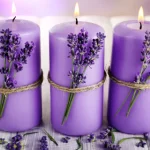Lavender and candle pairings work because lavender contains linalool, which lowers your stress hormones and helps you sleep better. Good quality candles use real essential oils and natural waxes like soy or beeswax. Burn them for 2 to 4 hours before bed, and you’ll notice better sleep and less anxiety. UK brands offer excellent options that bring spa-quality calm straight to your home.
There’s something about lighting a lavender candle at the end of a long day. The flame flickers, the scent fills the room, and suddenly you can breathe again. Your mind stops racing. Your body relaxes.
Life in the UK can feel relentless. Work demands pile up, the weather stays gloomy, and genuine rest feels impossible to find. But here’s the thing: you need relaxation just as much as you need sleep or food. It keeps you healthy, focused, and sane.
Combining lavender and candle rituals gives you an instant reset button. The scent calms your nervous system while the candlelight creates warmth and peace. Want to bring this into your daily routine? Let’s get into exactly how it works and why it matters.
Why Lavender is the Go-To Relaxation Scent?
Lavender sits at the top of every calming scent list for good reason. It affects your brain, your body, and your emotions all at once. When you know how it works, you can get more out of it.
Lavender’s Natural Calming Science
Your limbic system controls your emotions, and lavender speaks its language. When you breathe in lavender, those linalool molecules shoot through your olfactory bulb straight to your amygdala and hippocampus. These brain regions handle stress and emotional memory.
Real studies back this up:
- A 2012 study in Evidence-Based Complementary Medicine showed lavender cut anxiety by 45% in people about to have surgery
- Wesleyan University researchers found it boosted deep sleep by 20%, and people woke up feeling actually rested
- Japanese scientists watched cortisol levels drop within 30 minutes of smelling lavender
This isn’t just about a nice smell. Lavender changes your body’s chemistry.
Historic & Modern Rituals
Old-time doctors gave lavender for “troubles of the mind.” Tudor families scattered it on floors to freshen rooms and calm nerves. In World War I, British nurses used lavender compresses on soldiers suffering from shell shock.
We keep these traditions alive today:
- Dropping lavender oil in evening baths
- Drinking lavender tea before sleep
- Spraying lavender mist on bedding
- Lighting lavender and candle sets during meditation or stretching
People adapt old knowledge to fit modern life.
Did you know?
Queen Elizabeth I drank lavender tea every single day and insisted on having fresh lavender at her table all year. Her love for it helped turn lavender into Britain’s go-to relaxation herb!
Lavender in Everyday UK Life
British people work lavender into their routines in ways that go way beyond aromatherapy. Look around and you’ll spot it constantly.
Beauty shelves stock lavender face creams, body lotions, and hair products because it fights inflammation. Bakeries and restaurants serve lavender shortbread, honey, and cocktails. Home shops sell reed diffusers, drawer sachets, and, of course, candles that keep spaces smelling fresh. Gardens across the country grow English lavender (Lavandula angustifolia), and farms in Norfolk, Yorkshire, and Kent welcome thousands of visitors who come just to see the purple fields.
Lavender feels both old-fashioned and current at the same time. That’s why it sticks around.
How Candles Elevate the Lavender Experience?
Adding a candle to lavender takes it from nice to necessary. The flame and the scent work together to create something bigger than either one alone. Understanding what makes a good candle helps you pick ones that actually work.
Why Candlelight Enhances Calm?
Fire does something to humans. We’ve gathered around flames for millennia, so our brains link them to safety and warmth. That’s why candles make any room feel instantly cosier.
Pairing light with scent makes the effect stronger. Studies found that using multiple senses together (sight, smell, touch) cut stress by 60% more than using just one. Your body and mind respond better when you give them more signals.
Light a lavender candle, and you hit two relaxation triggers at once. Your eyes watch the gentle flame, which quiets your thoughts. Your nose takes in lavender’s calming compounds. The combination works faster and goes deeper.
Candle Ingredients Matter
Not every lavender candle does what it promises. What’s inside makes all the difference.
Real lavender essential oil contains the therapeutic linalool that actually calms you. Synthetic “lavender fragrance” smells similar but does nothing for your stress levels. Check the label. Good candles say “lavender essential oil,” not vague words like “fragrance” or “parfum.”
Wax type matters too:
- Soy wax: Burns clean, breaks down naturally, and holds scent well. It works great if you have sensitivities.
- Beeswax: Comes from nature, produces ions that clean the air, and adds a subtle honey note that goes nicely with lavender.r
- Coconut wax: Burns slowly and throws scent beautifully
- Paraffin: Comes from petroleum, costs less, but releases stuff you don’t want to breathe when it burns
Pro Tip:
Look for cotton or wooden wicks in your candles. Some metal wicks contain lead and release toxins when they burn. Natural wicks keep the air cleaner.
Choosing Your Perfect Lavender Candle
Finding the right candle comes down to a few key factors:
Scent strength:
Do you want a gentle background lavender or room-filling aroma? Label descriptions give you clues:
- “Subtle” or “gentle” means lighter, background scents
- “Intense” or “bold” means a strong, noticeable fragrance
- “Medium” sits comfortably in between
Wax type:
Match the wax to what matters most to you:
- Soy for eco-conscious buyers who want clean burns
- Beeswax for the purest, most natural option
- Coconut for luxury performance and scent throw
Burn time considerations:
- Larger candles (200g and up) burn for 40 to 50 hours
- Smaller versions (around 100g) give you 20 to 25 hours
- Think about how often you’ll light it
Luxury features:
Some UK artisans add special touches that enhance both beauty and aromatherapy:
- Dried lavender buds pressed into the wax
- Amethyst crystals for added visual appeal
- Complementary botanicals like chamomile or bergamot
Lavender Candles for Sleep, Stress, and Self-Care
Lavender and candle rituals solve three of the biggest wellness challenges people face: poor sleep, constant stress, and no time for self-care. Let’s break down how to use them for each.
Lavender for Better Sleep
Lavender helps you sleep in several ways. The scent increases your slow-wave sleep (the deep stages where your body repairs itself) and cuts down on how often you wake up during the night.
A study in Frontiers in Behavioural Neuroscience tracked people who smelled lavender before bed for five nights. The results showed:
- ~20% jump in deep sleep duration
- ~15% fewer nighttime wake-ups
- Much better sleep satisfaction scores
- More alertness and energy the following day
This proves lavender improves sleep quality, not just quantity.
Here’s how to use lavender candles for sleep. Light your candle 30 to 60 minutes before bed. Let the scent spread through your bedroom while you get ready for sleep. Blow it out 10 to 15 minutes before you actually lie down (never sleep with burning candles). The lingering scent keeps working as you drift off.
Stress Busting with a Lavender Glow
Three out of four UK adults deal with chronic stress, according to Mental Health Foundation surveys. Creating intentional relaxation moments helps break that cycle.
Many people find that burning a lavender candle after difficult workdays creates an immediate shift. Within minutes, physical tension starts to release. Tight jaws unclench, shoulders drop, and the mind begins to let go of work stress. The ritual becomes a clear boundary between professional demands and personal time.
This works because of something called associative conditioning. Your brain learns to connect the lavender and candlelight with relaxation. After a while, just lighting the candle triggers calm before the scent even kicks in.
Try using lavender candles for:
- Unwinding after work
- Morning meditation or journaling
- Difficult conversations that need calming energy
- Focused work sessions when you need mental clarity
- Sunday evenings when Monday anxiety hits
Elevating Your Spa-Night Ritual at Home
You can create professional spa experiences without leaving your house. Here’s how:
- Run a warm bath and add Epsom salts for muscle relaxation
- Light two or three lavender candles and place them around the bathroom on stable, heat-resistant surfaces away from water
- Dim or turn off overhead lights so candlelight becomes your main source of light
- Add lavender bath oil or fresh lavender sprigs to the bathwater
- Prepare lavender tea or infused water to sip while you soak
- Apply a lavender face mask or use a lavender body scrub
- After your bath, moisturise with lavender body lotion while your skin stays damp
- Continue the ritual in your bedroom with soft music, a good book, and your still-burning lavender candle
This costs a fraction of spa prices but delivers the same relaxation.
How to Safely Enjoy Lavender and Candlelight?
Getting the most from your candles means knowing how to use them properly and safely. A few simple practices make a big difference in both effectiveness and safety.
Best Practices for Aroma & Ambience
Scent layering tips:
Lavender pairs beautifully with complementary scents. Try combining it with:
- Chamomile for extra sleep support
- Bergamot for mood lifting
- Vanilla for cosy warmth
- Sandalwood for grounding
- Ylang-ylang for stress relief
Skip strong competing scents like peppermint or citrus. They create olfactory confusion and cancel out lavender’s benefits.
Ideal candle placement:
- Position candles at nose height when you sit down for the best scent dispersion
- Keep them about 3 feet from your seating area (too close overwhelms, too far weakens the effect)
- Small rooms (bedrooms, bathrooms) need only one medium candle
- Large spaces (living rooms, open-plan areas) work better with two or three strategically placed
Burn time guidelines:
First burn is crucial:
- Let the entire top surface melt (takes 2 to 4 hours)
- This prevents tunnelling and ensures even burning throughout the candle’s life
Regular burns:
- Burn for 3 to 4 hours maximum (longer causes wick mushrooming and excess smoke)
- Never burn for less than 1 hour (creates tunnelling)
Essential safety rules:
- Never leave burning candles unattended in any room
- Keep away from drafts, curtains, and flammable materials
- Always use heat-resistant surfaces
- Trim wicks to 5mm before each lighting
- Extinguish if the flame becomes too high or flickers repeatedly
- Keep out of reach of children and pets
Allergy & Sensitivity Considerations
Most people tolerate lavender beautifully, but some experience sensitivities. Here’s what to watch for.
Essential oil concentration matters. Quality candles use appropriate dilution (typically 5 to 10% essential oil). Higher concentrations can irritate sensitive individuals. If you experience headaches or breathing issues, look for candles labelled “light” or “gentle.”
Testing new candles safely. If you have sensitive skin or respiratory conditions, start slowly. Burn for just 15 minutes initially and watch for any reactions. Gradually increase burn time if no issues occur.
Special Considerations for Specific Groups:
- Pregnant women might want to avoid concentrated lavender during the first trimester, though properly diluted candles are generally safe. Always consult your midwife or GP first.
- Young children over 5 can safely enjoy lavender, but never use candles unsupervised in children’s rooms. Consider electric warmers or diffusers as safer alternatives for younger kids.
- Asthma sufferers rarely have issues with essential oil candles, but monitor your response carefully. Choose soy or beeswax over paraffin to minimise potential irritants.
- People with photosensitive epilepsy should use lower concentration candles with good room ventilation, as strong scents might very rarely trigger reactions.
Pro Tip:
If you love lavender but candles bother you, switch to electric wax warmers or diffusers with lavender essential oil. You get all the aromatherapy benefits without any combustion byproducts.
Takeaway
Pairing lavender and candle rituals gives you more than a nice ambience. It’s a proven way to genuinely relax, sleep better, and handle stress. Pick candles made with real lavender essential oils and natural waxes. Follow safe burning habits. Build rituals that tell your mind and body it’s time to unwind. Your well-being deserves these small but powerful acts of self-care.
Finding candles that deliver on these promises makes all the difference. Brands like anatomē focus on creating lavender and candle products with sustainably sourced essential oils and natural waxes. They work on balancing therapeutic effectiveness with quality craftsmanship, which is exactly what you need when building wellness rituals that actually stick.
FAQs
Will lavender candles help me sleep?
Yes, lavender candles improve sleep quality by lowering stress hormones and boosting deep sleep stages. Light them 30 to 60 minutes before bed for best results, then blow them out before sleeping.
Are essential oil candles really better for you?
Essential oil candles give you real aromatherapy through active compounds like linalool. Synthetic fragrances lack therapeutic benefits and may include irritating chemicals, making essential oil versions the healthier choice.
How long should I burn a lavender candle for maximising effect?
Burn lavender candles for 2 to 4 hours per session. This spreads the scent properly and melts the wax evenly. Your first burn should reach the container edges to prevent tunnelling.
Can I use a lavender candle in my child’s room?
Lavender is safe for children over 5, but never leave burning candles alone in kids’ rooms. Electric warmers or diffusers are safer options for younger children’s spaces.
What’s the difference between English lavender and French lavender in candles?
English lavender (Lavandula angustifolia) smells sweeter and more delicate, perfect for relaxation. French lavender (Lavandula stoechas) has stronger, sharper notes. Most relaxation candles use English varieties.
How do I know if a lavender candle uses real essential oil?
Check ingredient lists for “lavender essential oil” or “Lavandula angustifolia oil.” Vague terms like “fragrance,” “parfum,” or “lavender scent” usually mean synthetic alternatives. Good brands clearly state essential oil use.










